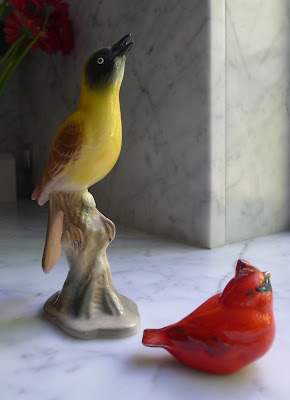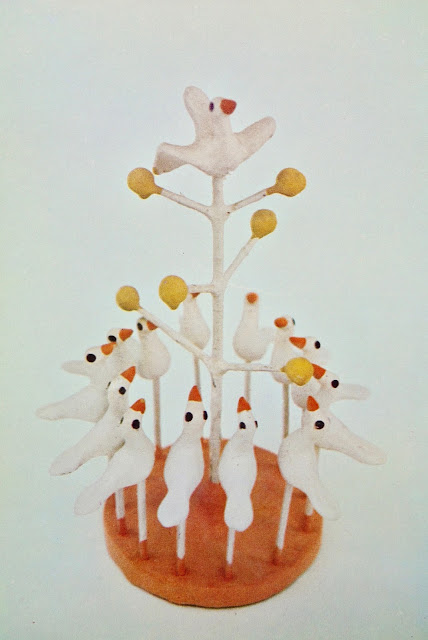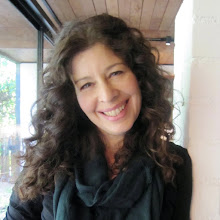Birds are some of the most ancient creatures on this planet. They have inhabited roles of spiritual messengers and omens for many indigenous cultures. They have the ability to see magnetic fields that guide them on their yearly cycles from north to south and back again. They're quite decorative, assuming a phenomenal array of colors and patterns. A frequent subject of painters their quirky shapes make for wonderful images. Their gaze is intense and their talons are sharp making them sometimes threatening as in Hitchcock's "The Birds". They are also graceful and gentle and the dove with an olive branch serves as the classic image of peace. Something to listen to while you look at this here.
Above and below: The fantastic illustrations of Miroco Machiko.
Above: Owls make a terrific subject. Their flat faces and huge eyes make for truly striking portraits in various mediums. Illustration by Miroko Machiko.
Above: A pair of Screech Owls, from the book "Beauty in Nature". Photographer and writer Dr. V.J. Stanek, published in Prague, 1955.
Above and below: Leila Jeffrey's bird portraits. Lesser Sooty Owl above, Southern Boobook below.
Above: My grandmother as a little girl, dressed in a bird outfit.
Above: Masao Yamamoto, From Kawa= Flow #1638, 2015
Above: Howland Owl figurine from Pogo, a gift from our friend Sandra Mathers. Pogo was a comic strip created by Walt Kelly which ran from 1948-1975.
Above: Barn Owl detail, John James Audubon (1785-1851), from The Birds of America, plate 171.
Above: Great Cinereous Owl detail, John James Audubon (1785-1851), from The Birds of America, plate 351.
Above; Pablo Picasso, "Le Hibou Gris", 1953, painted terra cotta, 13-5/8" high.
Above: Pablo Picasso, "Le Grand Hibou", 1956, litho after his 1948 painting of the same name.
Above and below: Bird symbols from ancient Mexico. These were found in "Design Motifs of Ancient Mexico by Jorge Enciso, Dover publications, 1953. These symbols have so much character...the one above looks like a body builder, the one below looks a little tipsy, though it may just be a feather indication, and the one below that looks eager and up for anything. The image above is thought to represent a Kingfisher, and was found in Veracruz. The two below are from Mexico City.
Above: This King Pigeon is named Picasso. He was paint splattered when he was found in San Francisco by a rescue organization as a baby, and nursed back to health. His story here.
Above: Elizabeth Clarkson with a bird in her living room in Charlotte N.C. Clarkson loved birds so much she had a special window put in so birds could come and go. She is said to have had a black bird nesting in her book shelves. The garden, created by Elizabeth and her husband Eddie in the 1930s and named Wing Haven, was made with all sorts of elements to attract birds...pools, fountains, flowering trees and feeders. No cats! Clarkson studied ornithology in the early 30s, and in 1948 succeeded in having DDT banned in Charlotte for 5 years, till business interests fought to have it back. It was finally banned again in 1972.
Thanks to Lisa Eisner for including this wonderful image here and sharing Elizabeth Clarkson's story.
Above: My brother Josh Clayton-Felt, making friends with a crow who was a regular at the house where he was staying. The crow, named Fernando, became a character in a radio play my mom wrote about Josh's life after he passed away in 2000. The play is called Lightsong, and my mom's husband produced it as a podcast. This photo is by my brother's friend Renee Faia.
Above: Henri Matisse holding a dove while drawing it's portrait. Photo by Henri Cartier-Bresson, Vence, 1944.
Above: Louise Bourgeois, photo by Alex Van Gelder, 2015.
Photo by Van Riel, Buenos Aires
Above and below: Burt Lancaster in the role of the Birdman of Alcatraz, 1962, based on a true story.
Above: Georges Braque sitting by one of his distinctive bird images, 1963. Photo by Luc Fournol.
Above: A drawing from Braque's notebook.
Above: Georges Braque "White Bird", glazed ceramic plate, Galerie Maeght, 1961.
Above: Peter Doig, Untitled Bird, 2011, monotype in watercolor.
Above: Album cover "Reminiscing", Phil Moore at the piano, 1950.
Above and below: Ceramics by Makoto Kagoshima, from a book of his work published by Chariots on Fire, 2017. Art direction by Ritsuko Yagi, photos by Shuji Yoshida.
Above: Detail of Makoto Kagoshima plate.
Above and below: Hand printed wallpapers designed by Marthe Armitage available here. They're printed in an offset litho process. More about Marthe Armitage here.
Above: Wallpaper sketch "Feathers" drawn by Paule Marrot (1902-1987)
Above: Paul Thevenaz, Design for a Screen, Tropical Birds, 1920. Cooper Hewitt collection.
Above: Plate by Venice, California artist Magdalena Suarez Frimkess.
Above: From Enid Blyton's Nature Lover Book, first published in 1944, illustrated by Donia Nachsen and Noel Hopkins.
Above: Trellis wallpaper designed by William Morris and Phillip Webb, 1862. This sample collection Victoria and Albert Museum.
Above and below: I discovered this wallpaper in the closet of an old house for sale in Santa Monica Canyon. The house had belonged to a family of artists...Lee, Luchita, and Matt Mullican. The surprising nature of the discovery in 2010 was probably the subliminal impetus to make me think of hiding a bird wallpaper in the show house Annica Howard and I designed in 2016 which you'll see below.
Above and below: A couple of years ago Annica Howard and I undertook the renovation of a bedroom in a design show house, Wattles Mansion. The show house theme was to choose a movie for inspiration and we chose Hitchcock's "The Birds". The bird theme and the movie's color palette ran through our room in various ways. We included birds in a gentler way than they were portrayed in the film. We chose this beautiful wallpaper from Sanderson with hummingbirds scattered in the grasses and hid it as a surprise inside a closet. We included this photo (a favorite of mine), "Point Reyes" by Jason Frank Rothenberg, 2014, below as it was shot near the film location and there's a flock of very un-menacing quail gathered in the foreground. The path pulls you into the distance increasing the sense of space in what was a very small room. The landscape color also reflected the color of Tippi Hedren's sage green suit she wore throughout the film.
Above and below: Photos by Jean-Luc Mylayne. Enormous patience and time was required as he'd wait for months for a bird to perch in just the right spot in just the right position at just the right time of day. He has special lenses custom made to create optical effects of focus and blurriness. Great piece about Mylayne here.
Above: Alen MacWeeney, Birds, Bloody Foreland, Donegal, 1967.
Above: Winifred Nicholson, Sandpipers, Alnmouth, 1933.
Above: Milton Avery (1885-1965), Southern Sea.
Above: Milton Avery, March with Doves.
Above: Claude and Alice Monet, his 2nd wife, in St. Marks Square, Venice, October 1908.
Above: Italian actress Virna Lisi feeding the pigeons in St. Mark's Square, Venice, 1959.
Above: Snow White singing to a bird companion in the 1937 movie.
Above: Masao Yamamoto, #550, from a box of Ku, 1998, Etherton Gallery
Above and below: In what seems like a fairytale, Safet Halil, from the village of Zaritsa in Bulgaria found five frozen storks on the road. They'd been migrating and were caught in a cold snap. Halil brought them home, placed them before a warm fire, and fed them fish. Happily they recovered. Because of the social media attention other people started taking the frozen storks home and more than 40 birds were saved. Photos by Dimitar Dilkoff for Getty images.
Above: Hans Thoma (1839-1924), Wondrous Birds, 1892.
Above: Walter Anderson (1903-1965) watercolor, Two Bitterns.
Above and below: A Bowerbird collecting nesting materials. Bowerbirds are known for making their nests in single colors and the more decorative they are, the better they attract a mate. Some good examples here.
Above: William Morris's best known and most popular fabric design, "Strawberry Thief". It was first successfully printed in 1883 using an ancient technique called indigo discharge. He based the name on the thrushes at his home, Kelmscott Manor, in Oxfordshire, who stole his strawberries.
Above: Josef Frank "Green Birds", 1943. Frank, a Jewish Viennese architect left Austria (with his Swedish wife) for Sweden in 1933 to get away from increasing Nazi discrimination. In Sweden he couldn't find work as an architect but over a number of years designed 160 joyfully colorful fabrics for the company Svenskt Tenn, whose owner Estrid Ericson believed in his talents. Frank became a Swedish citizen in 1939.
Above: Ann Craven, untitled
Above and below: Joseph Cornell box, "The Hotel Eden", 1945, and the same box showing up in a Simpsons episode below.
Above: A few years ago at the art book fair at PS1 in NY. I picked up this lovely handmade book of drawings by Sachiyo Oishi. Her drawings capture the essence of the way birds position themselves, hold their heads, and fill out their bodies.
Above and below: Bill Traylor (1853-1949), a self taught artist from Alabama. Traylor was born into slavery, became a share cropper after he was emancipated, and only started making art at the age of 85. From 1939-1942 he produced about 1500 pieces. His work was brought to the attention of the art world through the efforts of Charles Shannon, who first encountered Traylor in 1940. In the late 1970s his work started to be taken seriously, leading to exhibits at the Corcoran in 1982, the Met in 1995, and MoMA in 1996. This September the Smithsonian will be hosting the largest exhibition of his work to date, and the first retrospective there for an artist born into slavery.
Above: Judith Hopf, from her show "Cracking Nuts", 2014 at Kaufmann Repetto, NY.
Above: Bird mask, Papua, New Guinea
Above: Hugo Guinness, from his book "Sketches from a Google Safari", 2015.
Above: Milton Avery, Beach Birds, 1954, woodcut
Above: Haniwa Chick. Haniwa figures were unglazed terra cotta sculptures, positioned by graves 250-552 CE.
Above: Haniwa Duck, 250-552 CE Tokyo National Museum.
Above: Inside Jane Rosen's studio. Her work can be found at Sears Peyton Gallery.
Above: Jane Rosen, Morandi Installation, 2012
Above: Ancient Egyptian Barn Owl
Above: Bird, 2nd millennium BC. Collection LACMA
Above: Vintage folk art wood bird.
Above: Bird sculpture by Dan Hamilton, an artist working at Creative Growth.
Above: From Alexander Girard Foundation's Folk Art Collection, painted wood birds, Puerto Rico.
Above: A client's porcelain birds on her kitchen counter.
Above and below: From an Incomplete Dictionary of Show Birds by Luke Stephenson. Red Canary above, Java Sparrow Mutation Opal Pastel below.
Above: Bird carving, Gupapuyngu people, 1963.
Above: Folk art Sandpiper decoy
Above and below: Japanese driftwood birds by Osamu Harihara at Scout, Santa Barbara.
Above: Photo by Xiaoming Zhang
Above: Costume by Charles and Ray Eames.
Above: "Paper Faces" by Michael Grater, 1968.
Above: Virginia Tech Hokie Bird Mascot, 1960s.
Above: Photographer unknown. Love the spirit!
Above: Wearing Penguin costumes, 1928, France.
Above: Masao Yamamoto from his book Tori, 2016
Above and below: Chairs with bird names. Harry Bertoia's Bird Chair, designed in 1952, above, and Arne Jacobsen's Seagull chair from the 1960s below.
Above: Woven basket birds...found here.
Above and below: Kathleen Ryan's sculpture "Parasol", 2017. Ceramic and powder coated steel. At Ghebaly Gallery, Los Angeles
Above: From Alexander Girard Foundation's Folk Art Collection, painted pottery from Brazil.
Above: Diviner's Staff, birds, 19th-20th century, Nigeria, Yoruba peoples
Above: Masao Yamamoto, from the book "Tori". Kawa = Flow # 1666
Above: Helen Macdonald, author of the memoir H is for Hawk, with her goshawk Mabel. Photo by Joel Brouwer.
Above and below: Roger Tory Petersen, Author of the ionic series of guide books like the one below. Photo by Alfred Eisenstaedt. An Osprey by his side seems curious, a companion.
Above and below: A guide book published by Doubleday from 1915.
Above: Baltimore Orioles vintage baseball cap.
Above: A classic!
Above and below: A how to draw children's book by Ed Emberley with a technique of building upon simple shapes.
Above: A wall of bird figures in the Girard Wing, Museum of International Folk Art, Santa Fe.
Above: Some of the birds on the folk art wall seem to be modeled on this bird, the African Hoopoe. In the 12th century Persian legend, The Conference of Birds, the Hoopoe bird is the leader taking all the other birds to find their true king through the valleys of quest, love, understanding, detachment, unity, amazement, and death. A beautifully illustrated version of the legend by Peter Sis can be found here.
Above: Black and White Cockatoo, (sulphur crested cockatoo) 1813, watercolor by T.R. Browne.
Above: The Layson Albatross, part of their courtship dance. Photo by Joe Fuhrman
Above: From the book "Secrets of Nature", by V.J. Stanek, a chaffinch feeding it's young.
Above: "The Friendly Robin", Illustration by Eileen A. Soper from the Enid Blyton Nature Readers, 1945.
Above: Illustration by L.K. Deal for a Robert Louis Stevenson poem, Elson Reader, 1920s. There's a robin on a branch outside the window.
Above: Clarence House Fabric, "Robin" Verde Mare.
Above: Donghia Fabric, "Bees Knees", Fresh Green colorway.
Above: In China it's a tradition to take your songbird to the park. In the park the cages are hung near each other on low branches, giving both birds and bird walkers a chance to socialize.
Above: African cotton fabric with a wonderful image of birds flying free out of their cages.
Above: Paul Klee, Bird Garden, 1924. There's an excellent essay from the Independent about this painting here.
Above: Owl, Jozef Susienka, 1982
Above: Masao Yamamoto Kawa = Flow #1684, 2016
Above: Egyptian Vulture
Above: Woodstock and Snoopy, from Peanuts.
Above: Leila Jeffrey's portrait, Orange Chat, Amanda, 2015
Above: Leila Jeffrey's bird portrait.
Below: Tweety Bird












































































































































